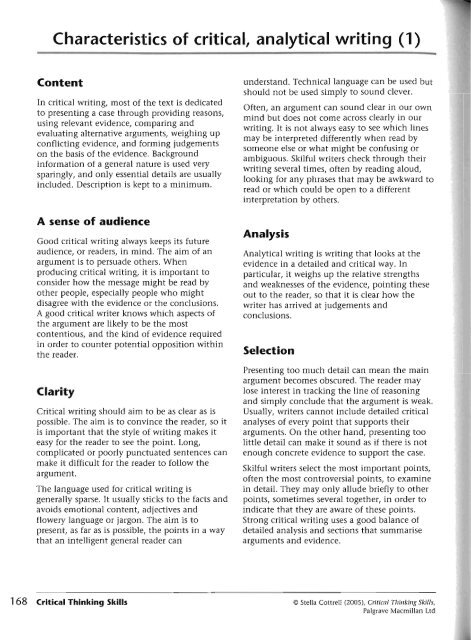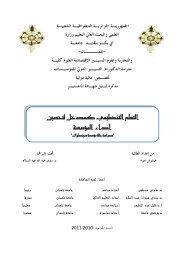Critical Thinking Skills - Developing Effective Analysis and Argument(2)
Critical Thinking Skills - Developing Effective Analysis and Argument(2)
Critical Thinking Skills - Developing Effective Analysis and Argument(2)
Create successful ePaper yourself
Turn your PDF publications into a flip-book with our unique Google optimized e-Paper software.
Characteristics of critical, analytical writing (1)<br />
Content<br />
In critical writing, most of the text is dedicated<br />
to presenting a case through providing reasons,<br />
using relevant evidence, comparing <strong>and</strong><br />
evaluating alternative arguments, weighing up<br />
conflicting evidence, <strong>and</strong> forming judgements<br />
on the basis of the evidence. Background<br />
information of a general nature is used very<br />
sparingly, <strong>and</strong> only essential details are usually<br />
included. Description is kept to a minimum.<br />
A sense of audience<br />
Good criticaI writing always keeps its future<br />
audience, or readers, in mind. The aim of an<br />
argument is to persuade others. When<br />
producing critical writing, it is important to<br />
consider how the message might be read by<br />
other people, especially people who might<br />
disagree with the evidence or the conclusions.<br />
A good critical writer knows which aspects of<br />
the argument are likely to be the most<br />
contentious, <strong>and</strong> the kind of evidence required<br />
in order to counter potential opposition within<br />
the reader.<br />
Clarity<br />
<strong>Critical</strong> writing should aim to be as clear as is<br />
possible. The aim is to convince the reader, so it<br />
is important that the style of writing makes it<br />
easy for the reader to see the point. Long,<br />
complicated or poorly punctuated sentences can<br />
make it difficult for the reader to follow the<br />
argument.<br />
The language used for critical writing is<br />
generally sparse. It usually sticks to the facts <strong>and</strong><br />
avoids emotional content, adjectives <strong>and</strong><br />
flowery language or jargon. The aim is to<br />
present, as far as is possible, the points in a way<br />
that an intelligent general reader can<br />
underst<strong>and</strong>. Technical language can be used but<br />
should not be used simply to sound clever.<br />
Often, an argument can sound clear in our own<br />
mind but does not come across clearly in our<br />
writing. It is not always easy to see which lines<br />
may be interpreted differently when read by<br />
someone else or what might be confusing or<br />
ambiguous. Skilful writers check through their<br />
writing several times, often by reading aloud,<br />
looking for any phrases that may be awkward to<br />
read or which could be open to a different<br />
interpretation by others.<br />
<strong>Analysis</strong><br />
Analytical writing is writing that looks at the<br />
evidence in a detailed <strong>and</strong> critical way. In<br />
particular, it weighs up the relative strengths<br />
<strong>and</strong> weaknesses of the evidence, pointing these<br />
out to the reader, so that it is clear how the<br />
writer has arrived at judgements <strong>and</strong><br />
conclusions.<br />
Selection<br />
Presenting too much detail can mean the main<br />
argument becomes obscured. The reader may<br />
lose interest in tracking the line of reasoning<br />
<strong>and</strong> simply conclude that the argument is weak.<br />
Usually, writers cannot include detailed critical<br />
analyses of every point that supports their<br />
arguments. On the other h<strong>and</strong>, presenting too<br />
little detail can make it sound as if there is not<br />
enough concrete evidence to support the case.<br />
Skilful writers select the most important points,<br />
often the most controversial points, to examine<br />
in detail. They may only allude briefly to other<br />
points, sometimes several together, in order to<br />
indicate that they are aware of these points.<br />
Strong critical writing uses a good balance of<br />
detailed analysis <strong>and</strong> sections that summarise<br />
arguments <strong>and</strong> evidence.<br />
168 <strong>Critical</strong> <strong>Thinking</strong> <strong>Skills</strong> 0 Stella Cottrell (ZOOS), <strong>Critical</strong> Tilinking <strong>Skills</strong>,<br />
Palgrave Macmillan Ltd



